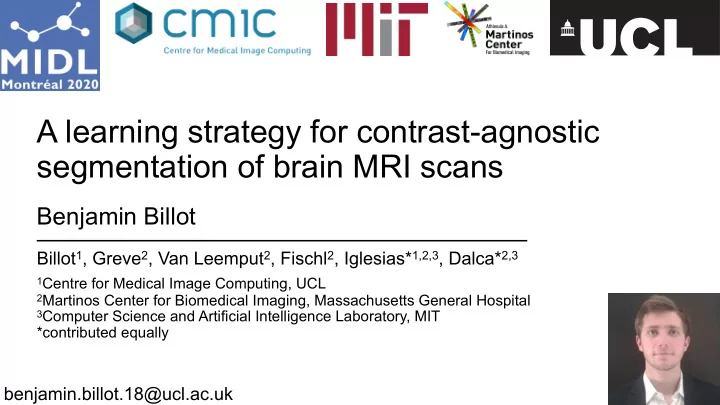

A learning strategy for contrast-agnostic segmentation of brain MRI scans Benjamin Billot Billot 1 , Greve 2 , Van Leemput 2 , Fischl 2 , Iglesias* 1,2,3 , Dalca* 2,3 1 Centre for Medical Image Computing, UCL 2 Martinos Center for Biomedical Imaging, Massachusetts General Hospital 3 Computer Science and Artificial Intelligence Laboratory, MIT *contributed equally benjamin.billot.18@ucl.ac.uk
Segmentation Segmentation method 2
Types of methods Methods Speed Modality-agnostic Manual --- +++ Multi-atlas segmentation - + Bayesian segmentation + ++ Supervised CNN +++ --- 3
Modality-specific CNN T1 Supervised CNN 4
Supervised segmentation T1 Supervised CNN T2 Supervised CNN T1 + T2 Supervised CNN 5
Problems with supervised CNNs • only work on modalities they were trained with • sensitive to pre-processing • require supervised data 6
Solution: Synthesise data… CNN trained with synthetic data 7
…of random contrast ! Set of anatomical segmentations SynthSeg Supervised CNN 8
Outline Introduction Methods • Generative model • Training Experiments and results • Experimental set-up • Results Conclusion 9
Generation of T1 contrast Spatial GMM deformation sampling Label map Blurring Bias field 10
Generation of random contrast Spatial GMM deformation sampling Label map Blurring Bias field 11
SynthSeg training overview Predicted label map Generated image Modality Label map agnostic CNN Image generative model Backpropagation Average Dice loss Deformed label map Data generation 12
Outline Introduction Methods • Generative model • Training Experiments and results • Experimental set-up • Results Conclusion 13
Datasets T1-39: 39 subjects Training Testing T1mix: 1,000 subjects ABIDE ADHD HABRE GSP MCIC OASIS PPMI FSM: 18 subjects T1 T2 DBS T1-PD-8: 8 subjects 14 T1 PD
Competing methods • T1-baseline: T1 supervised CNN • SAMSEG [1]: modality-agnostic Bayesian segmentation • SynthSeg • SynthSeg-rule: trained with realistic contrasts [1] Puonti et al., Neuroimage, 2016. 15
Dice scores T1mix 16
Dice scores T1mix 17
Dice scores T1mix 18
Dice scores T1mix 19
T1 segmentation examples Ground Truth T1 baseline SAMSEG SynthSeg SynthSeg-rule T1-39 T1-FSM 20
T2-PD segmentation examples Ground Truth T1 baseline SAMSEG SynthSeg SynthSeg-rule T2-FSM N/A PD-PD8 N/A 21
Key points • SynthSeg enables fast contrast-agnostic segmentation of brain MRI scans, without retraining. • SynthSeg does not require any preprocessing. • SynthSeg only requires a set of segmentations as training data. • Augmentation beyond realistic measures enables better generalisation. 22
Future directions SynthSeg PV-SynthSeg 23
Acknowledgments Funding: Collaborators: 24
Useful links • A Learning Strategy for Contrast-agnostic MRI Segmentation MIDL 2020 https://arxiv.org/abs/2003.01995 • Partial Volume Segmentation of Brain MRI Scans of any Resolution and Contrast MICCAI 2020 https://arxiv.org/abs/2003.01995 • Generative model: https://github.com/BBillot/lab2im • SynthSeg: https://github.com/BBillot/SynthSeg 25
Recommend
More recommend